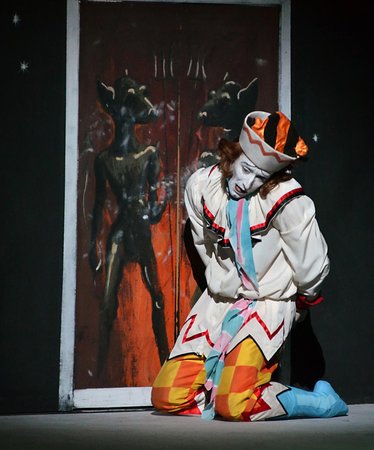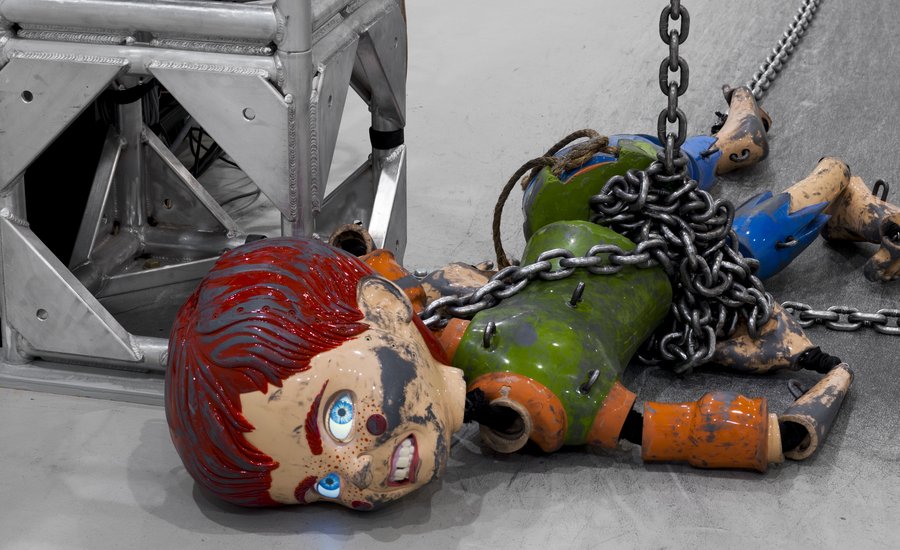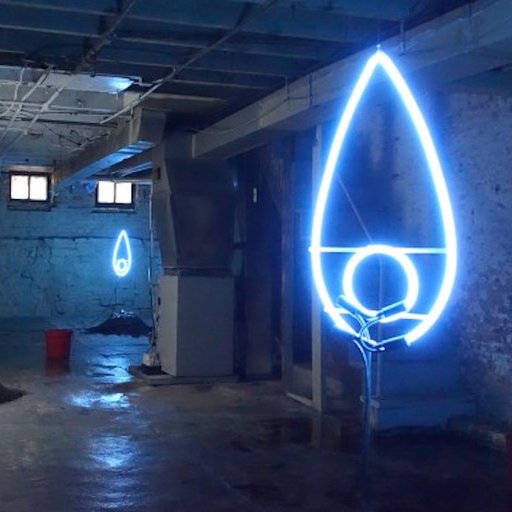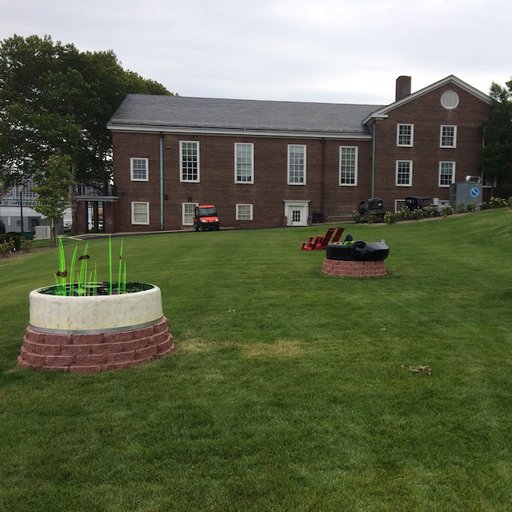In 1911, the old folk tale of Petroushka came to life on the Paris stage as a ballet scored by Igor Stravinsky, choreographed by Michel Fokine, and performed by Sergei Dhiagilev’s Ballet Russes. Set in Russia, the plot of the ballet involves three puppets—Petroushka, the Ballerina, and the Moor—that are brought to life by a character known as the Charlatan. Petroushka falls in love with the Ballerina, but she rather prefers the Moor. Petroushka, unable to cope with such a blow to his pride, challenges the Moor to a duel. The Moor wins and kills Petroushka, but as night descends, Petroushka’s ghost rises to haunt both the theater and the Charlatan until at last the feckless puppeteer collapses. In recent months, this ballet has come to haunt me once more, in part thanks to Jordan Wolfson.
Last May, Wolfson debuted a new sculpture at David Zwirner Gallery in New York. In light of his prior showpiece there in 2014—an animatronic robot of a dancing, mostly nude woman in a witch mask, titled Female figure—it feels more appropriate to refer to each exhibition as a debut, like a product debut. This is the new model, the new character, the new gadget, the new monstrosity that we all line up to see. The piece is called Colored sculpture, a title that was embarrassingly left unanalyzed by just about every bit of press the show received.
Wolfson describes the piece rather succinctly in talking to Artinfo: “The artwork is a figurative sculpture based on Huckleberry Finn, Alfred E. Neuman, and Howdy Doody. It’s a cartoony, life-size figure that’s almost like a piece of sports equipment. It has six points around the body, and it’s rudimentarily animated from three of these points. It’s similar to other characters I’ve used in my films, but it’s ultimately a new character. It also has eyes, which are video screens with special glass lenses on top. It’s able to make eye contact with viewers, like [Female figure]. The character goes between anger and pain. Animated content plays in the video screens that serve as its eyes, along with live video footage I’ve shot. Formally, it’s extremely glossy, reflective.”
Since 2011, nearly all of Wolfson’s work has looked back at its viewer. The Shylockian caricature from Animation, Masks (2011) meets your eyes as he gestures, speaks, and pages through Vogue. His redheaded cartoon character from Raspberry Poser (2012) looks back as well, while he screams at you, disembowels himself, and maniacally gestures with jazz hands. His sculpture, Female figure, was his first foray into animatronics and facial recognition software, mechanically activating its gaze so that it followed the viewer around the room. His characters all have their own particular admixture of playful and resentful contempt for the viewer, and his newest sculpture is no exception.
It is a strange and haunting piece. The body is broken up into various sections, made of a material that feels as resilient as an ocean buoy. It is animated by a series of three chains attached to its head, one hand, and one foot, all hanging from a gantry system. Despite three simple points of contact, its range of activity is impressively poetic. Furthermore, there is an occasional soundtrack: from time to time, Percy Sledge’s famous 1966 track “When a Man Loves a Woman” barrels in, clipped and starting off midway through the song. It stops just as abruptly as it starts, making a normally sweet and sentimental song feel awfully suspect. The figure often menacingly hovers through the room, only to crash to the floor moments later, its limbs akimbo. Or it will slowly find itself in a pose, the chains clicking one by one like a roller coaster ride, until each limb finally hit its precise position like a strange, palsied dancer.
To my mind, Colored sculpture is in a way an updated version of Stravinsky’s Petroushka—a white puppet brought to life by the Charlatan, forever resentful of a world that didn’t let him have the girl. Worse yet, a world that would allow a Moor to get the girl. Who knows what a man will do when he loves a woman, with or without her love in return?
 Petroushka
Petroushka
The notion of music that mocks its subject was one way that the philosopher and critic Theodor Adorno separated Stravinsky’s work from what he thought was the more progressive work of Arnold Schoenberg. Whereas Schoenberg’s early Neo-Romanticism led to an inwardly withdrawn self that transcended singular subjectivity, “[s]uch pathos is totally alien to Stravinsky’s Petroushka…. In Stravinsky’s case, subjectivity assumes the character of sacrifice, but—and this is where he sneers at the tradition of humanistic art—the music does not identify with the victim, but rather with the destructive element. Through the liquidation of the victim it rids itself of all intentions—that is, of its own subjectivity.”
It could be argued that a similar sense of emptying out the subject is at play in Wolfson’s piece, that the complexity of the work is precisely that it keys in on high-octane emotionality while also evacuating it. It’s stupid to feel for the puppet; it’s impossible not to. What was felt by many who looked at Colored sculpture was a sense of loss, a feeling of repulsion and empathic care—slightly more complex than Adorno’s indictment of Stravinsky, but related nonetheless. Many saw in this figure a kind of pain and anguish that was brutalizing, but elegiac and existential. Yet unlike Petroushka, Wolfson’s music and dancer are both more ambivalent. Wolfson’s music both mocks and connects with the figure, and further still, Wolfson’s figure refuses liquidation through anger and vengeful scorn, resisting the wave of empathy that the music rides. Regardless of how many times he falls to pieces, the figure disregards sentiment, will not recognize it. He is both a figure of pain and a figure of ugly spite. The range of emotions is aggressively polar—we empathize, we recoil, we ache, we pause.
This collective and unquestioned “we” got me to conjure a thought experiment. Let us imagine for a moment that Colored sculpture was precisely that, a sculpture of a person of color. Let us imagine that, rather than seeing a red-haired white child, we saw a black boy hanging from the rafters. What then? My guess is that the reaction would have been different. Instead of feeling an empathic queasiness, a kind of universal wretchedness, I would wager that many would say that the piece is too “obvious,” too simple, too direct, too political, too “real.” Here is my first real indictment, and it’s not of Jordan Wolfson, but of the audience.
The white body, through its repetition in a history of art that is largely painted white itself, has become an easy and lazy signifier for a universal body, for a metaphorical body, one that becomes symbolic and slippery, that can always be more than its mere representation. The non-white body, I believe, has greater difficulty in attaining this metaphorical bounty. Kerry James Marshall has fought diligently and profoundly against this tide and won, but examples are unfortunately rare. This, of course, does not mean that black and non-white artists have not achieved this endlessly throughout history, but that, by and large, their work is still ghettoized, simplified, and misunderstood.
Let us banish the idea that the body in action is universal in any way. That brings us to the baser fact that it is a Caucasian body that is being flailed around—a Caucasian sculpture that is called Colored sculpture. Like most racism of the current moment, plausible deniability works like a well-oiled escape hatch. To call the work Colored sculpture might simply be a nod to classical sculpture which was painted in its inception but time has stripped it of its color, allowing us to believe that they were never painted or “colored” in the first place. Similarly, Wolfson’s sculpture began “colored” but as it is battered, that color will wear away. (I have no interest here in interrogating whether the artist himself is racist or not, and do not believe that is relevant when speaking to larger structural problems.)
This is a convenient and obviously insufficient explanation. The title leads me to believe something more sinister is at work (intentional or not), and that the resentment of this figure’s gaze is particular to our moment—a moment where just days ago a misogynistic, racist, resentful, angry, overbearing, incoherent, unqualified, and profoundly dangerous man was voted in as our next president of the United States, defeating a problematic but infinitely more qualified and able female candidate. What this indicates in, among other things, is a moment where the resentment of a swath of voters said to be in the “flyover zone” of America has reached a boil. We, the liberal-minded frogs, did not notice the pot’s temperature rising and are now potentially cooked.
 President-elect Donald Trump
President-elect Donald Trump
The left has largely forgotten about the white working class, as the end of Hillary Clinton’s campaign illustrates, although countless examples of the Democratic party's disregard could be brought forward. Their disgust with the political establishment has caused them to sign on to just about anything other than what appears to be politics as usual. This means that they helped vote in the least qualified president in history. To call some percentage of them idiots, racists, or misogynists might in some (or many) cases be true, but it does nothing to treat the problem, much less fix the divisiveness that allows such resentment to build in the first place. These people feel left behind, abandoned by a government that they believe is run by elites that couldn’t care less about them. The problem remains that there were a set of conditions that made it possible for an orange-faced puppet to get voted into the highest office in America.
Despite these issues that will remain at large and must be addressed by the left, this boiling resentment has fueled a moment where white victimhood is thought to be as pressing an issue as the institutionalized murder of black people in America. Many white men today feel themselves under attack, usually because of the burn of growing equitability. It is becoming clear that “when you are accustomed to privilege, equality feels like oppression.” (The attribution of this quote is unknown, but it has gained quite a bit of momentum on the internet.) Thus, we have a breed of white males who believe they are persecuted while being the aggressor, and are powerful while maintaining a sense of painful fragility. This kind of cognitive dissonance cannot be brushed off.
This is our contemporary pollution, and this is what Wolfson’s piece more fittingly diagnoses. We are in a moment where many feel their liberty, their spirit, their individualism, their right to arms, and their money threatened—and Wolfson has crafted a character that can be seen to evoke these very problematic ideals. Here is a petulant child, tumbling down in anguish and so easily mangled, yet made of incredibly durable materials, mechanized and sustained by a series of massive moving parts, and exhibited in one of the most titanic galleries in the world. Tell me, how shall I pity him. This freckled, sneering, bucktoothed boy distills something deeply unsettling about our moment and potentially our foreseeable future. This is not just any body, not a universal body, this is a white male body, and it is haunting us.
Ajay Kurian is an artist, curator, and writer who shows with New York's 47 Canal Gallery and will be featured in the 2017 Whitney Biennial. This is the latest installment of his column, Jottings.

























